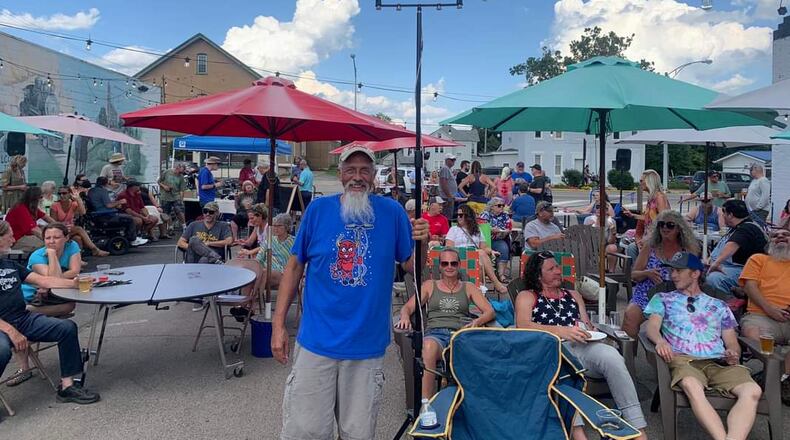Though not officially allowed until the formation of the “taper section” in the 80s, an entire music subculture revolved around taping and trading those tapes, and still does — the technology has just evolved from ephemeral cassettes to lossless digital files.
This progression has taken tapers from sneaking in equipment — with fake casts and through venues’ bathroom windows — to relive the music, to the jam bands themselves leaning into the phenomenon with taper-specific tickets that land them a primo spot behind the soundboard.
But while smuggling equipment into live shows transcends genre (see: the tapers of Ween, Robyn Hitchcock, Meat Puppets, et al), it also transcends popularity — down to the local level.
Brian “Brain” Boyd is one of the many tapers who carry that spirit over to the small time, though he has been known to tape a Billy Strings concert or twenty.
Boyd’s first encounter with taping was at a Dead show at Sandstone Amphitheater in Bonner Springs, KS, on July 4, 1990. He patched out an on-loan DAT (digital audio tape) deck from another DAT recording the show, essentially meaning Boyd got a hand-me-down feed.
Daisy-chaining decks is a common, albeit precarious, system among tapers. Boyd once saw 15 decks daisy-chained at a String Cheese Incident show, noting that deep faith in wiring must be had in its practice.
Around 1998, when Boyd retired from the Air Force, he and a buddy went in on some microphones. He bought a Tascam DAT which subsequently taped myriad shows from ‘98 to 2006, manifesting an entire wall of once-blank cassettes into an archive.
Taping, as established, is the preferred verbiage for what Boyd does; however, the term “bootlegging” is sometimes misappropriated to describe tapers.
“Bootlegging implies that you’re selling the music and that’s strictly forbidden,” Boyd said. “It’s an agreement between the artists and tapers that if you’re going to record, you’re expected to share the music freely. It’s an enforced thing among tapers.”
Boyd cited a recent Facebook post of someone who came across old Allman Brothers’ reel-to-reels. The tapes weren’t in circulation and there was only brief talk of the cost before everyone put the hammer down; it’s malpractice for tapers to make money off the music.
There seems to be a gray area with that commandment since Boyd’s paid hundreds of dollars for dubbed Maxell cassettes over the years. His reasoning: the medium, the cassette, is worth a little money.
Cassettes have a fleeting shelf life. The adhesive that holds the oxide to the tape breaks down over time, and if that oxide falls off, so does the music. Boyd spent the pandemic transferring nearly 600 tapes to hard drives.
He wanted to preserve the time capsules, calling revisiting shows “a nice trip down memory lane” — some of which he’d frankly forgotten about.
Boyd isn’t certain how many hours he’s recorded but estimates it to be in the thousands.
From 2006 to now, all of Boyd’s recordings have been digital — straight to SD cards — recorded with an arsenal of dynamic, cardioid and hypercardioid microphones at his disposal. He then takes those recordings and uploads them to Archive.org — the accepted taper upload locale — where they’re available worldwide. He currently has 191 uploads on his profile, though that’s just what he’s got around to.
“I’m an archivist at heart,” Boyd said. He’s avoided taping bigger acts in recent years, citing heightened security safeguards at larger venues being increasingly less accommodating (i.e. lax) to tapers.
And while he did follow around Billy Strings for a couple of years — not to mention his time taping the Dead, among other bands — Boyd eventually collapsed his boom pole on the multi-thousand seaters to rededicate his services to sharing local music.
“The Dayton music scene is loaded with exceptional musicians,” Boyd said. “It’s worth documenting that for future generations of music lovers.”
But Boyd said taping is a dying art form.
Take the live concert-specific streaming service, Nugs — which offers sterile soundboard recordings for a monthly fee — and the mic placement, chatter, energy and feeling of the audience, the human element, is rendered peripheral.
Tapers capture the live show experience for the ones who weren’t able to make it, and for the ones who did make it and want to revisit through a bit of audio archeology.
Despite Boyd saying taping is waning, he’s not the only one in town.
Jim Malogorski’s mics are often up in the air alongside Boyd’s. Richard Brown filmed the music scene for 12 years before YouTube shut his channel down. And you might catch civilian taper Zak Gillman recording performances for his ears only.
Tapers come in different packages, but they’re still out there continuing the tradition of what started with the Grateful Dead and will continue long after Phish stops touring.
Out in the wild, if you see a boom pole in the air, thank your local taper, because only they can teach us how to listen to the music.
About the Author


